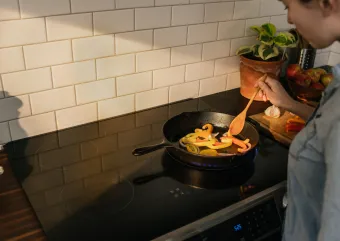Transitioning your cooking appliances to electric is a good way to improve your home’s health and safety. Traditional gas stoves impact indoor air quality and can negatively impact health, while electric ranges are more efficient and create less indoor air pollution.
Cooking
Gas-burning ranges can release pollutants like carbon monoxide and nitrogen dioxide, even when they’re off. These pollutants have negative effects on air quality and health, especially in younger children, vulnerable adults, and pets. Gas-burning stoves may also pose safety risks, especially because they can introduce open flames into the home. Electrifying your cooking will remove this source of indoor air pollution and danger from your home.
Summary
We’ve put together a chart to help you compare your electric cooking options so you can choose the range that will work best for your preferences.
| Induction Range | Electric Range | Compared To Gas | |
|---|---|---|---|
| Efficiency | 85% | 75% | 40% |
| Safety | Cooktop is not directly heated and is fast to cool | Cooktop gets hot and is slow to cool | Cooktop gets hot and is slow to cool |
| Cooking Power | Fast | Slow | Average |
| Cookware Compatibility | Most steel and cast iron | Any | Any |
System Options
The type of electric cooktop you choose will depend on your lifestyle and cooking preferences.
Induction Ranges
Induction ranges are energy-efficient electric appliances that can cook faster and more precisely than alternative options.
They heat cookware through a localized electromagnetic field, so the cooking surface is not heated directly. That can reduce the risk of burns and keep the ambient temperature in your kitchen down. However, it means that you’ll need compatible, magnetic cookware to use an induction range. Most steel and cast-iron cookware is compatible; aluminum cookware is not compatible.
If a full induction range isn’t an option for you, like if you rent, you can get a portable one- or two-burner induction cooktop for your home at a lower price.
Traditional Electric Ranges
Electric ranges are a little less energy efficient than induction ranges, but they are widely available and affordable. They create heat by running a current through a heating element, heating the cooktop surface. Your existing cookware will work on an electric range, but the surface can be slower to cool and less precise than an induction range.
Ventilation
No matter what type of cooktop you have, you should always use ventilation while you cook. Cooking produces steamy, humid air that can lead to building moisture issues. Plus, if you happen to burn something, you may produce harmful pollutants. Ventilation helps address both these problems, which is why we recommend using your vent hood or other ventilation options while cooking. You may work directly with a contractor to install additional ventilation if you do not already have it in place.
Installation and Contractors
Electric ranges need 240-volt plug, which an electrician can install for you. Once you’re ready to purchase your new cooktop, most major box stores offer appliance delivery and installation services. For details on what delivery and installation services are available, we recommend speaking directly to an employee at your preferred store.
Financial Incentives
Financial incentives for electric cooktops vary based on your location. For full financial incentive details, please visit our incentives page.
Electrify Your Clothes Drying with Electrify Everything Minnesota
Electrifying is personal. The choices you make for technology will depend on factors like your home, lifestyle, and budget. By providing this buyer’s guide, we hope to help you start unraveling where to begin for your unique needs. If you’re still not sure what cooktop you’d like and you live in one of our partner communities, talk to an advisor for free electrification advice. They can help you weigh the pros and cons of the different systems, so you feel more confident in your decision. If you live outside that area, we recommend connecting with a contractor to discuss your options.
